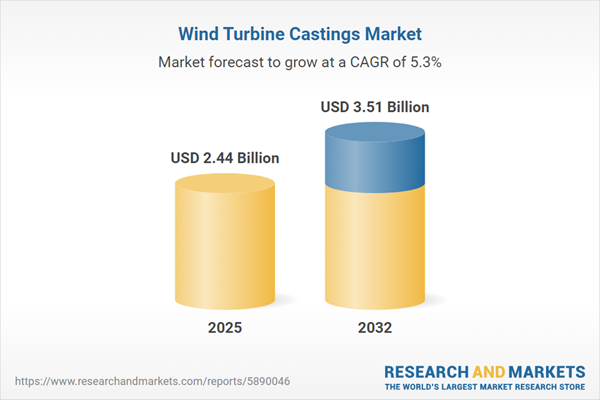Speak directly to the analyst to clarify any post sales queries you may have.
The wind turbine castings market is essential for organizations seeking reliable, scalable solutions within the global renewable energy landscape. Senior executives must navigate evolving technologies, supply chain risks, and new regulatory frameworks to secure competitive advantage.
Market Snapshot: Trends and Growth in the Wind Turbine Castings Market
The wind turbine castings market is on a growth trajectory, with its market value set to increase from USD 2.32 billion in 2024 to USD 2.44 billion in 2025, ultimately reaching USD 3.51 billion by 2032. This steady expansion, supported by a 5.32% compound annual growth rate, is primarily driven by expanding global investments in wind energy, ongoing technological innovations in casting methods, and a sector-wide commitment to decarbonization. Companies are responding to these market forces by creating regionally adaptive supply strategies, building strong supplier networks, and sharpening their focus on operational efficiency. The integration of advanced project management, agile supply chains, and enhanced quality controls continues to define competitiveness across this specialized industrial sector.
Scope & Segmentation: Strategic Insights for Decision-Makers
Designed to support executive leadership, this report delivers actionable intelligence across the entire wind turbine castings value chain, equipping stakeholders to assess risks and strengthen market position. Key segmentation insights include:
- Casting Types: Covers hub, flange, nacelle, tower, and yoke castings—each addressing distinct structural and operational requirements within turbine assemblies for reliability and performance.
- Materials: Considers ductile iron, grey iron, carbon steel, and stainless steel for enhanced durability, adaptability in various climates, and cost efficiency.
- Production Processes: Analyzes gravity die casting, sand casting, investment casting, and shell molding, helping businesses match component engineering methods to their efficiency and outcome targets.
- Capacity Ranges: Encompasses both distributed energy projects and utility-scale installations, supporting planning for a range of project sizes and complexity levels.
- Turbine Types: Evaluates onshore and offshore configurations, noting differences in logistics, climatic exposure, and maintenance that affect casting requirements.
- End Uses: Examines new installations and retrofit applications, highlighting the role of castings in prolonging asset value and supporting ongoing maintenance.
- Machining Status: Distinguishes finished from unmachined components, indicating variations in processing and assembly approaches.
- Geographies: Features regional dynamics across the Americas, Europe, Middle East, Africa, and Asia-Pacific, assessing local regulations, infrastructure, and supply chain considerations.
- Key Companies: Profiles market leaders including N.V. SIF, Georg Fischer AG, JFE Holdings, Doosan Heavy Industries & Construction, Bharat Forge Limited, China First Heavy Industries, Chengdu Cast Steel, JSW Castings, Henan Foundry Machinery Group, and Hangzhou Fuchun Industrial for strategic benchmarking.
Key Takeaways for Senior Decision-Makers
- Metallurgical advancements have bolstered the resilience of wind turbine castings, enabling dependable performance across challenging environmental conditions.
- Manufacturers employ digital simulation and predictive analytics, leading to higher precision and more proactive maintenance strategies throughout the asset lifecycle.
- Increased collaboration between original equipment manufacturers and specialized foundries supports tailored solutions to meet region-specific project demands.
- Procurement strategies are now prioritizing supplier diversity and establishing localized manufacturing hubs to address project scheduling and mitigate supply risks.
- Sustainability concerns drive the use of recycled inputs and adoption of closed-loop production processes, aligning with global emissions policies and maintaining product integrity.
- Quality assurance measures enhance decisions on material and machining specifications, yielding operational cost benefits and extending component lifecycle.
Tariff Impact: Adjusting Procurement Amid U.S. Duties
Recent U.S. tariffs on castings and raw materials are prompting organizations to reassess supplier relationships and consider nearshoring options in North America. These shifts help minimize exposure to trade fluctuations and regulatory uncertainties, while promoting timely delivery and project continuity along the supply chain.
Methodology & Data Sources
This report is based on rigorously validated industry data, regulatory filings, and direct consultation with wind turbine casting sector insiders such as foundries, OEMs, and trade associations. This approach ensures that executive teams receive precise and timely insights to guide high-impact decisions.
Why This Report Matters
- Empowers leadership to capitalize on growth prospects, integrate appropriate technologies, and form effective supplier partnerships across the casting value chain.
- Clarifies evolving market structures and regulatory requirements, supporting proactive, compliant decision-making in a volatile policy environment.
- Enables organizations to manage uncertainty, adapt to abrupt policy shifts, and deliver reliable project outcomes amidst marketplace change.
Conclusion
In the rapidly changing energy sector, expert analysis of the wind turbine castings market supports resilient strategies and informed leadership decisions for future growth.
Additional Product Information:
- Purchase of this report includes 1 year online access with quarterly updates.
- This report can be updated on request. Please contact our Customer Experience team using the Ask a Question widget on our website.
Table of Contents
3. Executive Summary
4. Market Overview
7. Cumulative Impact of Artificial Intelligence 2025
Companies Mentioned
The companies profiled in this Wind Turbine Castings market report include:- N.V. SIF
- Georg Fischer AG
- JFE Holdings, Inc.
- Doosan Heavy Industries & Construction Co., Ltd.
- Bharat Forge Limited
- China First Heavy Industries Co., Ltd.
- Chengdu Cast Steel Co., Ltd.
- JSW Castings Limited
- Henan Foundry Machinery Group Co., Ltd.
- Hangzhou Fuchun Industrial Co., Ltd.
Table Information
| Report Attribute | Details |
|---|---|
| No. of Pages | 184 |
| Published | October 2025 |
| Forecast Period | 2025 - 2032 |
| Estimated Market Value ( USD | $ 2.44 Billion |
| Forecasted Market Value ( USD | $ 3.51 Billion |
| Compound Annual Growth Rate | 5.3% |
| Regions Covered | Global |
| No. of Companies Mentioned | 11 |









